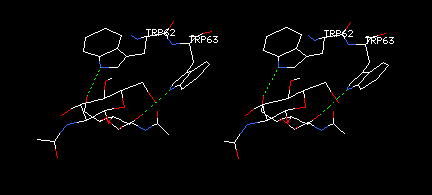

Thanks to students in my fall 1997 biochemistry course, and also to Nicolas Guex, for testing this tutorial and making many helpful suggestions. I will appreciate all comments, corrections, and suggestions.
Revised for Version 3.5b1 May 10, 1999.
If you are still using version 3.1 or earlier, I recommend that you obtain the latest version. As of 4/23/99, version 3.15b1 is only available from the Switzerland server, and not from PDB mirror sites.
SGI and Linux versions are now available. I am not yet aware if there are significant differences between these and the Mac and PC versions.
NOTE: Within the tutorial, links to supplementary information usually appear in a second browser window. The tutorial window is still open, behind the new window. After reading the accessory page, simply close the extra window to return to the tutorial, or move it behind the tutorial window for continued reference.
TEACHERS: Please request permission to use this tutorial
in your courses.
Here's
why.
USM Students: See Special Instructions.
SwissPdbViewer (hereafter called SPdbV) is a friendly but powerful molecular graphics program. It is designed especially for use with computing tools available from the ExPASy Molecular Biology Server in Geneva, Switzerland. While SPdbV is simple to use for viewing structures and creating vivid illustrations, it also shines as an analytical tool. SPdbV allows you to build models from scratch, simply by giving an amino-acid sequence. SPdbV can find hydrogen bonds within proteins and between proteins and ligands. It allows you to examine electron-density maps from crystallographic structure determination, and to judge the quality of maps and models. It allows you to view several proteins simultaneously and superimpose them to compare their structures. For proteins of known sequence but unknown structure, SPdbV submits amino acid sequences to ExPASy to find homologous proteins, onto which you can subsequently align your sequence to build a preliminary three-dimensional model. Then SPdbV submits your alignment to ExPASy, where a server called SWISS-MODEL builds a final model, called a homology model, and returns it to you by e-mail.
SwissPdbViewer is under continuing development by Nicolas Guex & Manuel C. Peitsch of Geneva Glaxo Welcome Experimental Research. Thanks to Glaxo, Nicolas, Manuel, and their colleagues for making this marvelous tool available to everyone. The program has been described in these articles:
In this tutorial, instructions for giving a command or using a menu will always appear in consistent formats. Usually, such commands will appear at the beginning of a new line. Here are some sample instructions and their meanings:
<return>
means press the key labeled return on the computer
keyboard. All key-press instructions are enclosed in <these things>,
and names of keys in written text are
underlined.
heading: show
means click on the word show, which is the heading
of the show column in the Control Panel.
Display: Backbone
means pull down the Display menu and select
Backbone.
All menu instructions are in bold type with a colon separating
the names of menus, submenus, and commands.
Next Section: 1. Getting Started